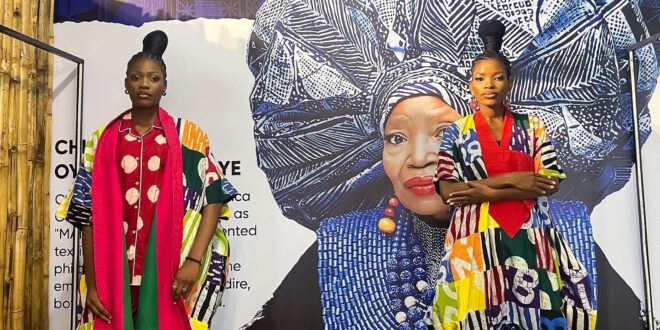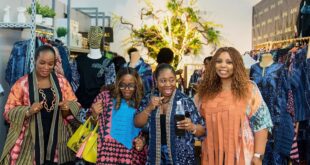Our contributing editor Tina Adomako reviews “Afrika in Mode. Luxus, Handwerk und textiles Erbe”, a new book written by Ghanaian designer Ken Kweku Nimo, in which African fashion designers narrate African fashion history.
“African” fashion has found its way into the Western fashion world for over a hundred years. Even when Black people were downgraded as primitive, it was and still is chic or avant garde to adopt individual elements of African fashion, which is often labelled “ethnic”.
Some call this cultural appropriation. A somewhat problematic accusation when you consider that art often develops through appropriation, transformation and reinterpretation. Artistic creativity can rarely emerge in a vacuum.
The colourful African prints are a classic example in fashion. The supposedly typical African fabrics with their lively patterns, which dominate the streetscape in all countries south of the Sahara, actually come from the Netherlands and have their origins in Java, Indonesia.

The beads, which have given rise to the unique beadwork of many ethnic groups such as the Xhosa, Zulu, Maasai or Ndebele, also originated outside Africa. European traders once brought them from Italy. Such information is revealed in the first chapter of the book, which deals with the history of African fashion.
The far greater part of the volume is dedicated to contemporary African fashion designers and their labels. From Imane Ayissi (Cameroon) to Taibo Bacar (Mozambique) and Mimi Plange (Ghana), designers are presented and their unique creations shown.
These can bear comparison to any famous haute couture labels, but are unknown to most people outside the fashion industry. While almost everyone will have heard of brands such as Chanel or Gaultier, very few people are familiar with Peuhl Vagabond, the label by Dyenaa Diaw, whose creations include ensembles made from traditionally woven African cloths and dyed textiles.
Batiked men’s suits, flowing robes made of woven Moroccan fabric with satin sleeves or jump suits that combine wax print with opulent silk fabrics are a feast for the eye. Interviews with some of the continent’s top designers about their inspirations and how they define luxury round also make a good read.
Even if I personally wouldn’t wear any of the outfits portrayed in this book (I probably couldn’t afford to anyway), it’s fun to leaf through this richly illustrated tome, which not only introduces one to Africa’s fashion elite, but also teaches a thing or two about the history of traditional fabrics such as Kente, Adinkra and the ever-popular wax prints. Also, it points to the direction from which the next top trends might be coming from.
Afrika in Mode. Luxus, Handwerk und textiles Erbe by Ken Kweku Nimo, 200 pages, Midas Verlag, 2024, 39,00 EUR. https://midas.ch/produkt/afrika-in-mode/
 THE AFRICAN COURIER. Reporting Africa and its Diaspora! The African Courier is an international magazine published in Germany to report on Africa and the Diaspora African experience. The first issue of the bimonthly magazine appeared on the newsstands on 15 February 1998. The African Courier is a communication forum for European-African political, economic and cultural exchanges, and a voice for Africa in Europe.
THE AFRICAN COURIER. Reporting Africa and its Diaspora! The African Courier is an international magazine published in Germany to report on Africa and the Diaspora African experience. The first issue of the bimonthly magazine appeared on the newsstands on 15 February 1998. The African Courier is a communication forum for European-African political, economic and cultural exchanges, and a voice for Africa in Europe.




